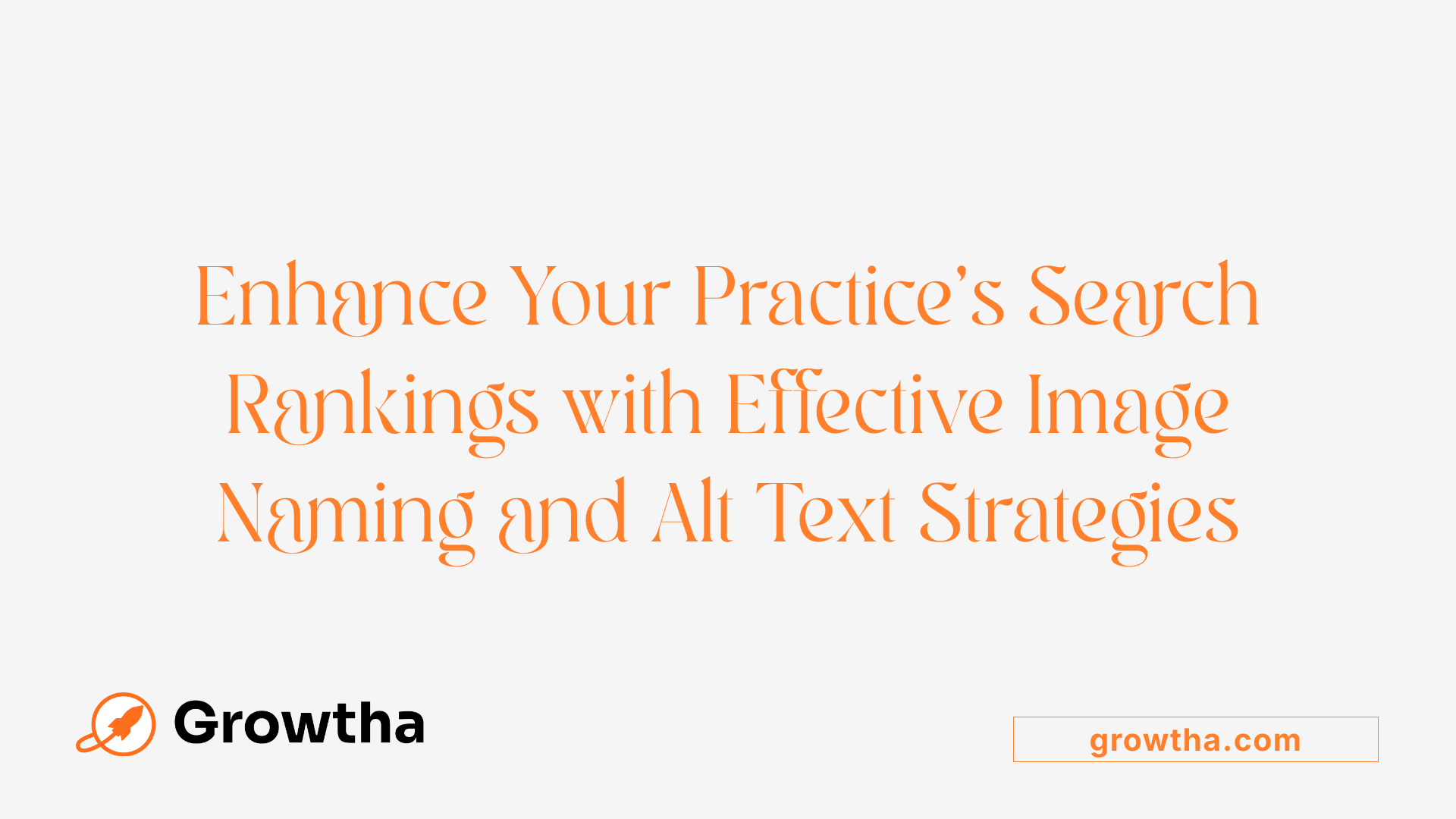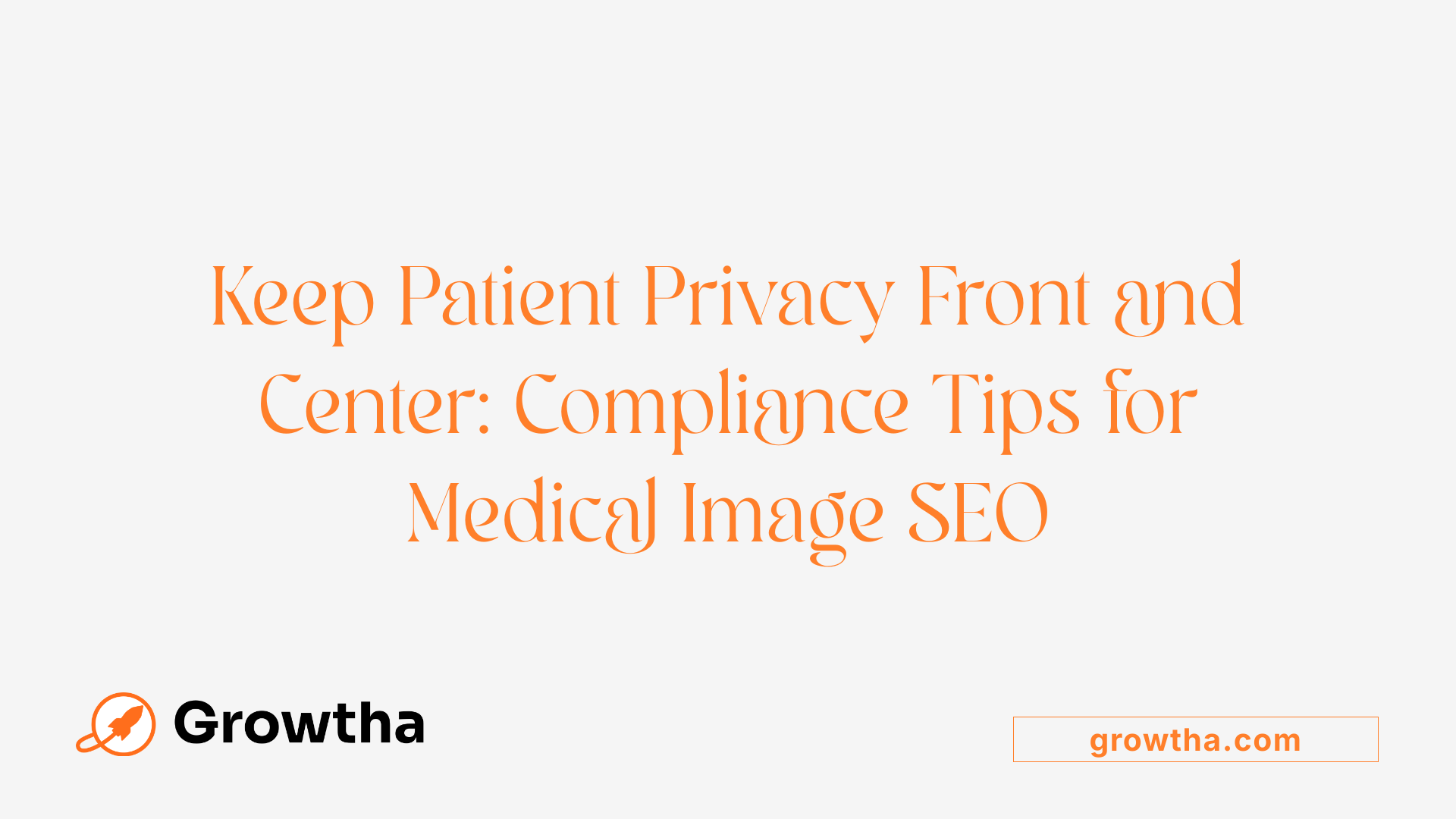Image SEO Tips for Medical Practices
Boost Your Healthcare Practice’s Visibility with Strategic Image Optimization


Image SEO Tips for Medical Practices
Enhancing Search Engine Rankings Through Effective Image SEO
In the competitive landscape of healthcare, having an optimized website is essential for attracting new patients and establishing trust. While many practices focus on content and technical SEO, image optimization remains a critical yet often overlooked component. Properly optimized images can significantly improve your site’s visibility in search engine results, especially in image searches, local listings, and rich snippets. This comprehensive guide dives deep into the principles, best practices, technical strategies, and practical tips to elevate your medical practice’s online presence through superior image SEO.
Understanding the Fundamentals of Image SEO in Healthcare
What are the general principles of SEO for medical practice websites?
Effective SEO for medical practices hinges on a well-rounded approach. This includes optimizing the website’s structure, ensuring content is relevant and high-quality, and addressing technical factors like mobile responsiveness and fast page load speeds. It’s vital to adhere to healthcare regulations such as HIPAA and Google’s E-A-T (Experience, Expertise, Authority, Trustworthiness) guidelines.
Local SEO plays a crucial role, which requires managing accurate Google Business Profiles, maintaining consistent NAP (Name, Address, Phone Number) information across all platforms, and actively encouraging and responding to patient reviews. This enhances visibility in local search results and on Google Maps. Creating engaging, trustworthy content such as blog articles, videos, and multimedia helps attract and educate patients, while earning backlinks from reputable sources builds site authority and improves rankings.
Online reputation management is an ongoing task, involving review solicitation and positive engagement on popular platforms like Google, Facebook, and healthcare directories. Regular content updates, SEO audits, and strategic keyword placement across various on-page elements ensure that a medical website remains relevant and competitive. Ultimately, these combined tactics improve online visibility, attract targeted local traffic, and foster patient trust.
The Role of Visual Content in Healthcare Websites

How images support educational content
Images play a vital role in medical website content by making complex health information more understandable. Visuals like diagrams, infographics, and photos help explain procedures, conditions, and treatments clearly. For example, an infographic illustrating the steps of a surgical process can demystify the experience for patients, reducing anxiety and increasing engagement.
These visuals complement written content, providing a quick understanding that text alone might not achieve. Well-designed images can break up long articles, making them more digestible and accessible, especially for visual learners.
Impact of visuals on patient trust and decision-making
High-quality, professional images of staff, facilities, and procedures foster trust. When patients see clean, modern environments and friendly staff photos, they feel more confident about choosing your practice.
Before-and-after photos showcasing successful treatments can serve as social proof, encouraging new patients to book consultations. Images that reflect professionalism and care reinforce your practice’s credibility, leading to better patient decisions.
Using multimedia to enhance SEO
Videos, images, and infographics are powerful tools to boost your website’s search visibility. Search engines prioritize websites with engaging, multimedia-rich content that keeps visitors longer. Embedding educational videos on procedures or health tips can increase site dwell time, signaling to Google that your site provides value.
Optimizing multimedia involves using relevant alt text, descriptive filenames, and structured data (schema markup) to help search engines understand the content. A well-optimized image gallery not only attracts visitors via search engines but also improves overall site experience.
Strategies to optimize medical practice image galleries for better SEO results
To make your image galleries work harder for your practice’s SEO, follow these strategies:
| Strategy | Description | Best Practices |
|---|---|---|
| Organize images with themes | Group related images into logical galleries to improve user navigation and relevance | Use clear, descriptive gallery titles and captions with keywords |
| Compress and scale images | Reduce image file sizes for faster load times without losing quality | Utilize tools like TinyPng or Squoosh; keep total page weight under 4MB |
| Use descriptive alt text | Improve accessibility and search indexing | Incorporate relevant keywords naturally within alt text |
| Standardize sizes and layouts | Create a consistent visual presentation across all images | Maintain aspect ratios and resolutions suitable for all devices |
| Regular performance analysis | Monitor how images affect site speed and user experience | Use Google PageSpeed Insights to identify issues |
Implementing these practices helps your practice's online visibility grow while providing patients with an engaging, trustworthy digital experience.
Technical Foundations for Image SEO in Healthcare
What guidelines should I follow for image SEO to enhance online presence and organic search rankings for healthcare providers?
Optimizing images plays a crucial role in healthcare SEO by making visual content more discoverable and engaging for potential patients. Start by incorporating relevant keywords naturally into filenames, alt text, and image captions. This helps search engines understand what the images portray, which can improve ranking in image search results.
Use descriptive and unique alt text for each image. Avoid generic descriptions; instead, focus on specific details like "interior view of XYZ Clinic’s waiting area" or "Dr. Jane Doe performing a minimally invasive procedure." Including your practice’s location and services in the alt text supports local SEO strategies.
Responsive images are vital for mobile friendliness. Use the srcset attribute to provide different image sizes based on the device’s screen resolution and size, ensuring fast load times without sacrificing quality. Implementing lazy loading techniques, which load images only when they are about to enter the viewport, reduces initial page load time and improves user experience.
Compress images appropriately using formats like WebP or using tools like TinyPNG or ImageOptim. Proper compression reduces file size while maintaining visual quality, leading to faster page speeds — a critical ranking factor. Combine this with leveraging browser caching and utilizing a content delivery network (CDN) to further enhance load times worldwide.
Include images in your XML sitemap to ensure they are indexed properly by search engines. Employ structured data markup, like schema.org vocabulary, to enrich your images with additional information. For instance, adding medical-specific schema can enable rich snippets that display star ratings, reviews, or FAQs alongside your images.
Local SEO can be supported by adding practice-specific NAP details or relevant geographic keywords within image metadata or surrounding content. Regularly update your visual content based on SEO analytics, patient feedback, and new treatments or facilities, keeping your site fresh and authoritative.
Consistently applying these technical image SEO practices will improve organic visibility, drive targeted traffic, and enhance your healthcare practice’s online credibility.
Optimizing Image Filenames and Alt Text for Search Visibility

Can you provide actionable tips for on-page image optimization for medical websites?
To make the most of image SEO on medical websites, start by using descriptive, keyword-rich filenames for all images. Instead of generic names like "IMG001.jpg," choose filenames that clearly describe the image, such as "dr-martin-exam-room.jpg" or "pediatric-patient-checkup.jpg." Incorporate relevant keywords naturally to help search engines understand the image content and improve your local SEO, especially by including location-specific terms if applicable.
Craft effective alt text that accurately describes each image. Alt text should be concise, relevant, and incorporate target keywords seamlessly. For example, instead of "doctor with patient," use "Board-certified ENT doctor examining patient in clinic, Los Angeles." Alt text enhances accessibility for users with visual impairments and boosts your chances of appearing in image search results.
Balance SEO with accessibility by ensuring your alt text serves screen readers and adheres to best practices. Avoid keyword stuffing; instead, focus on providing meaningful descriptions that reflect the image’s purpose.
Complement image optimization with the consistent use of high-quality, original photos of your practice, staff, and facilities. These images build trust and professionalism, and when optimized, can improve your local search rankings.
Optimize images further by resizing and compressing them to reduce page load times, which directly impacts your SEO and user experience. Use tools like TinyPNG or ImageOptim for compression without quality loss.
Implement responsive design so images display correctly across all device types. Incorporate images into your website’s XML sitemap to help search engines discover and index them.
Lastly, leverage schema markup, such as MedicalClinic or Physician schema, to provide additional context to search engines about your images and overall content, increasing the chance of rich snippets that enhance your search listings.
Altogether, combining these practices creates a powerful image SEO strategy that enhances visibility, accessibility, and professionalism of your healthcare website.
Leveraging Structured Data and Schemas for Image SEO
What guidelines should I follow for image SEO to enhance online presence and organic search rankings for healthcare providers?
Optimizing images correctly is essential for healthcare practices aiming to improve their search engine visibility. Start by using relevant keywords naturally within image filenames, alt text, and captions. Descriptive and unique descriptions help search engines understand the content, boosting the chances of appearing in image search results.
Fast load times are critical; compress images to reduce file size without losing quality and ensure they are responsive for mobile devices. This enhances user experience and aligns with Google’s ranking preferences.
Including images in your XML sitemap ensures they are discoverable and indexed effectively. Implementing structured data markup, specifically schema for healthcare, enables rich snippets—such as star ratings, reviews, and practice details—that can make your listings stand out in search results.
Local SEO can be supported by incorporating your practice’s NAP (Name, Address, Phone number) information into image metadata or local-specific keywords within your visuals. This helps Google associate your images with your geographic location.
Regularly evaluate your visual content strategy through SEO analytics tools. Focus on high-quality, patient-centered images that demonstrate professionalism and trustworthiness. Use multimedia such as before-and-after photos, staff pictures, and facility tours responsibly, ensuring compliance with privacy laws like HIPAA.
By consistently applying these image SEO practices, healthcare providers can increase online visibility, attract targeted patient traffic, and improve overall search rankings.
The Importance of Local SEO and Your Google My Business Profile

How can optimizing your Google My Business profile improve local SEO for healthcare practices?
Creating and maintaining a well-optimized Google My Business (GMB) profile is fundamental for healthcare providers aiming to attract local patients. When your GMB profile is complete with accurate practice name, address, phone number (NAP), and description, it enhances your visibility in local search results and Google Maps.
Uploading high-quality images of your practice, staff, and facilities can significantly boost your profile's attractiveness. These visuals help establish trust and convey professionalism. Additionally, utilizing the Q&A feature and routinely posting updates or special offers can keep your profile active and engaging.
What are the best practices for ensuring NAP consistency and citations?
Maintaining consistency in your Practice’s NAP across all online platforms—your website, GMB, healthcare review sites, and directories—builds trust for search engines and patients alike.
Discrepancies or outdated information can harm your local SEO rankings. It's advisable to regularly audit your NAP data and correct any inconsistencies.
Building citations on reputable medical directories like Healthgrades or Zocdoc further strengthens your local SEO efforts. These citations act as endorsements that validate your practice’s legitimacy and improve your prominence in local search results.
How do reviews influence reputation and search rankings?
Encouraging satisfied patients to share positive reviews on your GMB profile not only enhances your online reputation but also impacts your local SEO rankings. Reviews increase your practice's credibility and influence decision-making for prospective patients.
Managing your reputation involves responding promptly and professionally to all reviews, addressing concerns, and thanking patients for their feedback. This active engagement shows that your practice values patient input and fosters trust.
What content creation and technical considerations matter for medical image SEO?
Optimizing medical images involves using high-quality, relevant visuals with descriptive filenames and alt text that incorporate targeted keywords related to your practice and services. Proper compression ensures fast website load times, which is crucial for user experience and search rankings.
Technical elements such as implementing schema markup and structured data (like MedicalClinic or Physician schema) help search engines understand your images and content better. Creating an XML sitemap and submitting it to Google ensures all pages and images are effectively crawled.
Maintaining site speed, mobile responsiveness, and HTTPS security are essential technical considerations. Regularly updating your website with accurate and current medical content, validated by qualified professionals, aligns with Google’s E-A-T standards.
Effective site architecture, internal linking, and optimized meta tags—such as unique titles and descriptions—further improve your site's crawlability and relevance. Leveraging location-specific keywords in your content and on-page elements helps attract local search traffic.
In summary, integrating solid local SEO strategies with technical image optimization creates a powerful foundation to increase visibility, attract nearby patients, and establish your practice’s authority in your community.
Content Strategies and Human Psychology in Image Selection
How can medical practices improve visibility in image search results?
Medical practices can enhance their presence in image search results through several effective methods. First, optimize every image by using descriptive filenames that clearly reflect the content, such as "Dr-Jones-office-exterior.jpg" or "staff-meeting-room.jpg."
Secondly, incorporate relevant alt text for each image, which not only boosts SEO but also improves accessibility for users with disabilities. Alt text should include keywords naturally and describe what the image depicts.
High-quality images should be embedded thoughtfully within well-structured, relevant content. This integration helps search engines understand the context, elevating the overall search ranking.
To further improve visibility, ensure your website is mobile-responsive and loads quickly, as these are critical ranking factors. Using structured data markup (schema), especially healthcare-specific schemas, can enhance your listings with rich snippets, making your images stand out.
Location-specific content strategies such as claiming and optimizing your Google My Business profile, adding location-based keywords, and encouraging patients to leave reviews positively influence local image search rankings.
Regularly monitoring your SEO performance with tools like Google Search Console allows you to identify which images perform best and where improvements are needed. Updating and refining your images and content consistently will sustain and improve your visibility in image search results.
Implementing these strategies collectively helps your practice’s images appear more prominently, attract relevant local traffic, and ultimately increase patient engagement and new inquiries.
| Strategy | Details | Additional Notes |
|---|---|---|
| Descriptive filenames | Use clear, keyword-rich filenames for all images | Helps search engines understand image content |
| Alt text | Write concise, descriptive alternative texts with keywords | Improves accessibility and SEO |
| High-quality images | Upload professional and relevant images | Builds trust and engagement |
| Structured data markup | Use schema for healthcare images and content | Enables rich snippets and better ranking |
| Location and review optimization | Enhance Google My Business and gather reviews | Bolsters local image search visibility |
| Continuous performance monitoring | Use analytics to track performance and update content appropriately | Maintains search visibility and relevance |
By implementing these best practices, healthcare providers can significantly boost their images' search visibility, attract more local patients, and strengthen their online reputation.
Maintaining Compliance and Privacy in Medical Image SEO

What guidelines should I follow for image SEO to enhance online presence and organic search rankings for healthcare providers?
Medical practices must prioritize privacy and compliance when optimizing images for SEO. First, incorporate relevant keywords naturally into filenames, alt text, and image captions. This not only improves search engine understanding but also supports local SEO efforts if location-specific keywords are used.
Images should be optimized for load speed by compressing files without sacrificing quality and ensuring responsiveness for mobile devices. Fast-loading, mobile-friendly images contribute positively to both rankings and user experience.
Including images in your XML sitemap helps search engines index visual content efficiently. Additionally, utilizing structured data markup, such as schema.org tags for medical images or provider info, can enable rich snippets like star ratings or procedure details, increasing your practice’s visibility.
Local SEO can be enhanced by adding local keywords and including your practice’s NAP (Name, Address, Phone number) details within image metadata or as part of image captions. This helps attract nearby patients seeking specific services.
Monitoring your visual content using SEO analytics tools allows your team to refine your strategy based on what performs best. Focus on patient-centered content like staff photos, clinic facilities, and high-quality procedure images.
HIPAA compliance for images
Healthcare images often contain sensitive information. To comply with HIPAA regulations, never include identifiable patient information without explicit consent. Anonymize images by cropping or removing any personally identifiable details.
Patient consent and privacy considerations
Always obtain written consent from patients before capturing and publishing their images. Document the permission clearly, specifying how images will be used and stored.
Secure hosting and data security
Host all images on secure, HIPAA-compliant servers. Use HTTPS for data transmission to protect information from interception. Regularly audit your hosting environment to ensure it remains secure and compliant.
By following these guidelines, healthcare providers can effectively improve their online visibility while respecting patient privacy and adhering to legal standards, ultimately building trust and credibility with potential and existing patients.
Advanced Techniques and Emerging Trends in Healthcare Image SEO

What educational resources or guides on SEO best practices for image optimization in healthcare?
Yes, there are comprehensive resources available to help healthcare providers optimize images for SEO effectively. Industry-specific blogs, tutorials from leading SEO tools like Semrush and Ahrefs, and digital marketing agencies specializing in healthcare offer detailed guidance.
These guides typically cover critical aspects such as choosing the right image formats (JPEG, PNG, WebP), compressing images to enhance load speeds without sacrificing quality, and implementing descriptive alt text that includes relevant keywords. Alt text not only improves accessibility for users with disabilities but also helps search engines understand the content of images.
Lazy loading techniques are frequently recommended to improve website performance, especially on mobile devices. This approach loads images only when they come into the viewport, reducing initial load times.
Additionally, best practices emphasize maintaining compliance with medical standards and privacy laws such as HIPAA, ensuring that images do not contain identifiable patient data unless properly authorized. Ensuring accurate, high-quality images that reflect professionalism and care enhances both user trust and ranking potential.
Staying updated on evolving SEO standards and applying these strategies consistently can significantly boost a healthcare practice’s visibility in image search results, ultimately attracting more local patients seeking medical services.
Emerging schema types and rich snippets
As healthcare SEO advances, new schema markup types and rich snippets are emerging to enhance how practices appear in search results. Schema types like MedicalClinic, Physician, Review, and FAQ are now standard, providing structured data that search engines can interpret.
Innovative schemas such as Treatment, Condition, and Procedure schemas enable practices to showcase detailed information directly in search listings. Rich snippets like star ratings, appointment availability, practice hours, and FAQs can be displayed prominently, increasing click-through rates.
These enhancements do more than attract attention; they deliver precise user intent matching by displaying relevant details upfront. For example, a medical practice can markup detailed service descriptions and patient reviews, helping prospective patients make informed decisions at a glance.
Advanced schema configurations also include localized data, combining location, specialty, and service details to improve local search visibility. Integrating these schemas requires technical expertise but offers substantial benefits in standing out in crowded search results.
By leveraging cutting-edge schema types and rich snippets, healthcare providers can better communicate their unique offerings and expertise, making their listings more attractive and informative—driving higher engagement and fostering trust.
Measuring and Analyzing SEO Performance in Healthcare Image Optimization
How can medical practices improve visibility in image search results?
Medical practices can significantly enhance their presence in image search results by optimizing each visual element on their website. Using descriptive filenames and alt text that incorporate relevant keywords makes images more discoverable to search engines. Proper metadata, such as image titles and descriptions, further boosts visibility.
Incorporating these well-optimized images into a broader SEO framework that emphasizes high-quality, relevant content and a logical website structure improves the chances of ranking higher. Ensuring the website is mobile-friendly and loads quickly improves user experience and positively influences search rankings.
Structured data markup, such as schema.org, can help search engines understand the context of images, leading to better rich snippets and appearance in local image searches.
Location-specific content is especially beneficial for healthcare practices targeting local communities. Claiming and optimizing Google My Business profiles, along with encouraging satisfied patients to leave reviews, can also boost local and image search visibility.
To maintain and improve image SEO performance, practices should regularly monitor their metrics and update images and content accordingly, ensuring ongoing relevance and engagement.
Using analytics tools like Google Analytics and Search Console
Tracking the performance of healthcare images begins with tools such as Google Analytics and Search Console. These platforms provide detailed insights into how images are contributing to overall site traffic. Search Console offers specific data on how images appear in Google search results, including impressions, clicks, click-through rates, and position.
By analyzing this data, practices can identify which images are gaining visibility and which are underperforming. They can see if location-specific images or patient testimonials in visuals are resonating well or need adjustments.
Google Analytics helps assess how visitors interact with image-heavy pages, revealing whether images improve engagement and time spent on site. Combining these insights with heatmap tools can provide a comprehensive picture of user behavior and image effectiveness.
Tracking image search visibility
Practices should regularly check their rankings and visibility in Google Image Search, especially for high-value keywords related to medical procedures, specialties, or local neighborhoods. Some SEO tools offer specific features to monitor image search positions and identify competitive gaps.
Tracking the performance of image assets over time allows practices to discern trends and identify which image optimization strategies yield better results. This ongoing process supports proactive management of visual content.
Adjusting strategies based on data insights
Data-driven adjustments are vital for continual improvement. If analytics show certain images are not ranking well, consider improving their metadata, enhancing image quality, or aligning them more closely with frequently searched keywords.
Practices should also experiment with different formats, sizes, and placement of images on their websites. Adding new content, like patient success stories with before-and-after images, or updating existing visuals with fresh, optimized content, can rejuvenate visibility.
Furthermore, leveraging insights from user interaction data can guide the creation of new visual assets that better address patient interests and questions.
By regularly reviewing analytics and performance data, healthcare providers can refine their image SEO strategies, ultimately driving more traffic from image searches and enriching their online presence.
The Strategic Use of Content and Multimedia for Image SEO Success
What are actionable tips for on-page image optimization for medical websites?
Optimizing images on healthcare websites is crucial for improving search engine rankings and enhancing user experience. An effective first step is to use descriptive, keyword-rich filenames that clearly indicate the content of the image. For example, instead of generic names like 'IMG1234.jpg', use filenames such as 'dr-miller-exam-room.jpg'.
Alt text is equally important. It should be descriptive, naturally incorporating relevant keywords to help search engines understand what the image depicts, and to improve accessibility for users with disabilities. For instance, 'Front desk staff smiling in a modern medical office' provides context while integrating key phrases.
High-quality, original images of your practice, staff, and facilities not only boost local SEO but also build trust with potential patients. Professional photos of your team in action, your building’s exterior, and treatment rooms positively reflect your practice’s credibility.
Speed matters. Compress images to reduce load times without sacrificing quality. Using tools like TinyPNG or ImageOptim helps optimize images for fast mobile and desktop performance. Implementing a responsive design ensures images display correctly across various device sizes.
Including images in your website’s XML sitemap ensures search engines can efficiently crawl them. Schema markup, such as MedicalProcedure or Physician, can help enhance your images with rich snippets, increasing your visibility in search results.
Complement your image optimization efforts with overall site improvements. Clear calls to action, informative content, and accurate local SEO strategies—like consistent NAP (Name, Address, Phone Number) data and active Google My Business profiles—are vital for holistic SEO success.
By systematically applying these tactics, healthcare practices can significantly improve their image SEO, leading to higher rankings, better user engagement, and increased patient inquiries.
Harness the Power of Image SEO to Elevate Your Practice
Optimizing images for your medical practice isn't just about aesthetics—it's a strategic move to enhance your online presence, attract local patients, and build credibility. By following best practices such as descriptive filenames, alt text, responsive design, and structured data markup, you'll improve your chances of ranking in image searches and appearing in rich snippets, thereby increasing your visibility. Combining technical SEO with engaging, authentic visual content and robust local SEO strategies like Google My Business and review management ensures a comprehensive approach. Stay consistent, monitor results, and adapt your strategy based on analytics to continually improve your practice's digital footprint. Leveraging high-quality visuals in your website and online profiles will not only boost your search rankings but also foster patient trust and engagement, ultimately driving practice growth.
References
- SEO for Doctors: 11 SEO Strategies Specific to Medical Practices
- Healthcare SEO: 12 Expert Medical SEO Tactics
- Tips to optimize your practice's Google Business Profile images and ...
- How to Optimize Before-and-After Photo Galleries for Medical SEO
- SEO For Doctors - 14 Strategies To Grow Your Local Practice On ...
- 12 Steps to Effectively Implement SEO for Medical Practices
- Healthcare SEO: how to improve your organic performance
- SEO for healthcare: how to boost your medical practice's organic traffic
- SEO For Medical Practices: 14 Tips To Get More Traffic - Sagapixel







